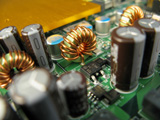GPRS
What is GPRS?
GPRS stands for General Packet Radio Service, and is a relatively low cost technology that offers packet-based radio service and allows data or information to be sent and received across mobile telephone networks.Designed to supplement the existing mobile technologies, like GSM, CDMA, and TDMA etc.
What does GPRS do?
GPRS provides a permanent connection where information can be sent or received immediately as the need arises, subject to radio coverage. No dial-up modem connection is necessary. This is why GPRS users are sometimes referred to be as being anytime-anywhere "always connected".The GPRS tariff structure is based on a fixed cost, dependent on the quantity of data required. In other words customers will be able to fix their operating costs without the concerns of variable billing.
Why GPRS?
At present circuit switching technique like your telephone line, in order to send or receive emails, transfer files or browse WAP/Web sites.it is first necessary to make a 'data' call. The call is answered by a modem or an ISDN adapter owned either by the network operator itself (such as BT Cellnet) or by an Internet Service Provider (ISP). Next the caller is 'authenticated' by giving a user ID and password and then assigned an Internet address by the ISP or operator. The whole process can take up to sixty seconds or more and even at the end of this procedure the connection is slow - normally a mere 9.6 Kbit/s.
With packet switching technique GPRS, there is no call. Once the handset is powered on, by pressing a button the user is connected directly to the Internet. The link is only broken when the handset is turned off - hence GPRS is known as an 'always on' connection. The fact that the link is continuous has one major benefit. It enables the ISP/operator to know a handset's Internet address. So messages can be passed directly over the Internet from a PC, for example, down to your handset. Crucially this facility enables the Internet Service Provider to 'push' messages down to your handset - rather like an SMS message. The difference is that with GPRS the link is interactive. That means if you want to respond directly - such as instruct your broker to sell 500 shares - you can. One of the major criticisms aimed at WAP is that it lacked support for 'push' technologies. This failing has effectively been rectified via an update to the WAP standards (version 1.2) and the introduction of GPRS enabled WAP handsets.
Download Book About GPRS
File name: gprs.docxUploaded: 2011-05-12
Download Link [Link]
Password:- gtuece







 Tool Tips, Comprehensive Online Help.
Tool Tips, Comprehensive Online Help.













